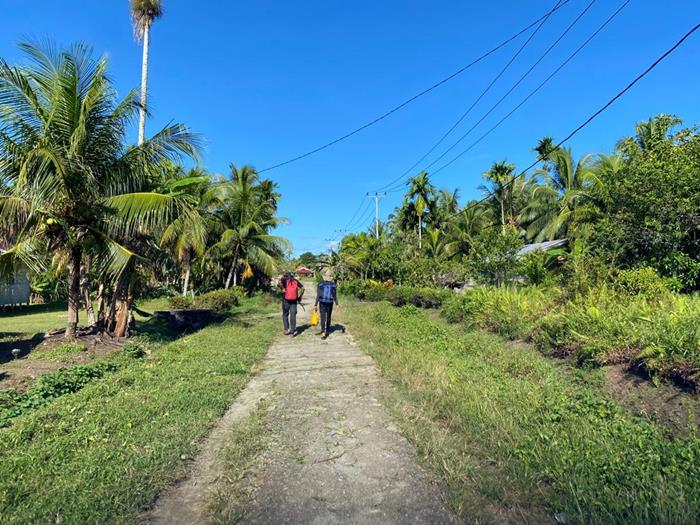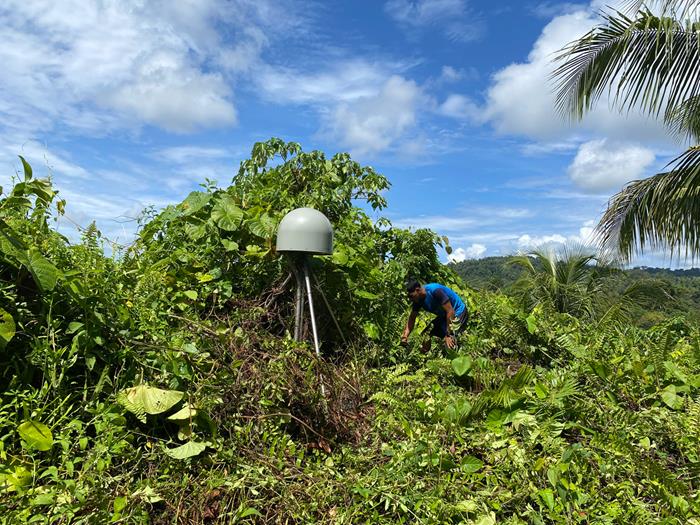In this blog series, we follow scientists from the Centre for Geohazard Observations (CGO) at the Earth Observatory of Singapore as they resume fieldwork activity after a hiatus due to the pandemic. During this first trip, they aim to maintain several Global Positioning System (GPS) stations of the Sumatran GPS Array (SuGAr) offshore Sumatra, and to install new stations. These stations observe the motion of plate tectonics along the Sunda megathrust, the plate boundary fault between the Indo-Australian plate and the Eurasian plate that has generated many great earthquakes. The CGO team ensures that the stations continue to observe the region’s tectonic activity, which ultimately helps prepare for the next earthquake.
The CGO team and its collaborators first headed to the Mentawai Islands, where several SuGAr stations are located. This region is within a seismic gap, a section of the Sunda megathrust that has not produced a great earthquake in nearly 225 years, and which is therefore prone to a large earthquake in the future.
The team first stopped at Sipora, where the regency capital of the Mentawai Islands, Tuapejat, is located. Here they maintained four stations of the SuGAr network. Each station presented its own surprises and challenges.

The CGO team with collaborators standing next to a SuGAr station (Source: Juniator Tulius/Earth Observatory of Singapore)
Getting to Sipora island took the team a few days. After a flight from Singapore to Jakarta then to Padang, a 9-hour long boat trip to Tuapejat, a drive, and a ride on motorcycles, the team reached the first GPS station called SIOB. The station was in good condition but the charger controller for the batteries was showing an error message. The team downloaded the data and changed the defective part, noting that they will need to come back to ensure everything is working before their return to Singapore.
In the early hours of the next day, it was time for a boat trip.

A wooden boat used by the CGO team to reach stations on remote islands (Source: Juniator Tulius/Earth Observatory of Singapore)
The team boarded two wooden boats to reach their next station, PKRT, located on an island about 1-hour away from Tuapejat. After the boats were beached, the team walked uphill on a concrete road to the station. There, they installed a new data receiver and met with local villagers who were curious about the team’s activities.
In addition to maintaining observation stations, engaging with local government and villages to inform about the team’s activities is an important aspect of this visit.

The team checking that a SuGAr station is working as expected (Juniator Tulius/Earth Observatory of Singapore)
The next station, TARA, is about 50 minutes away. To reach the station, the team walked through coconut gardens, passing through an older settlement that was devastated by the 2010 Mentawai tsunami. Ruins and remains of villagers’ houses are still visible to this day. Some villagers have rebuilt their home near the coastal areas where their coconut gardens are located, about hundred metres from the older settlement. There, the team met with the secretary of the village to engage and inform the local community about the activities undertaken.

The team walking through coconut gardens and settlements (Source: Juniator Tulius/Earth Observatory of Singapore)
The next stop was just 2 hours away, close to the nearby village of Katiet at the southern tip of Sipora. There, at the station called KTET, the team had a bit more maintenance to do. The station was in good condition, so the team downloaded the data and checked the batteries as usual. They also installed new solar panels to provide more power to the station, as they had planned. The additional task was to clear all the vegetation that had overgrown and was covering the GPS antenna, potentially affecting the quality of the data being recorded. Overall, it took a whole day to ensure good-quality data will continue to be recorded by this station until the next maintenance visit. The team ended the day by discussing the plans for the upcoming days.

Clearing overgrown vegetation is one of the maintenance tasks to ensure stations of the SuGAr network record good-quality data (Source: Juniator Tulius/Earth Observatory of Singapore)
During this first week of fieldwork, the team serviced four stations of the SuGAr network, and engaged with local communities to inform about their activities. Next, they headed south towards their next stations in North Pagai island, which will surely bring new surprises and challenges.

The smile of Dr Juniator Tulius, a member of the CGO team, shows the success of the fieldtrip so far (Source: Juniator Tulius/Earth Observatory of Singapore)
This work related to the maintenance of SuGAr stations located in Mentawai Islands is done in collaboration with Pusat Riset Kebencanaan Geology at the National Research and Innovation Agency (BRIN) in Indonesia.